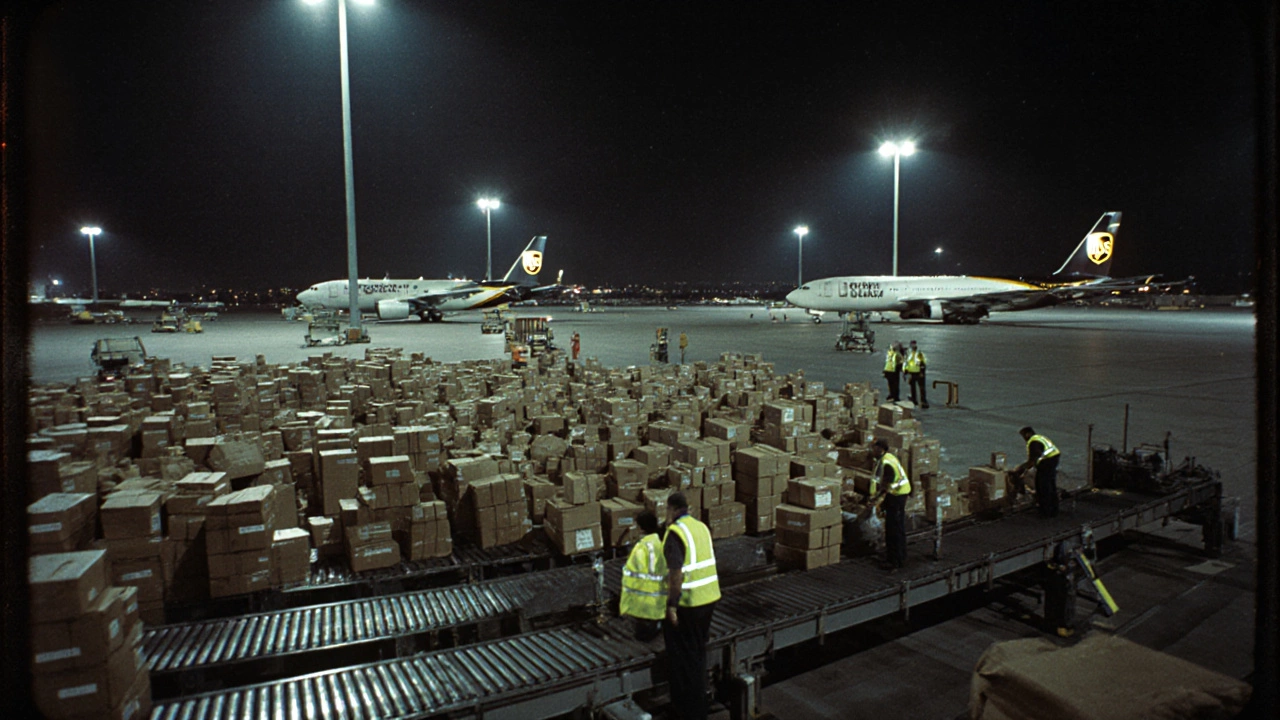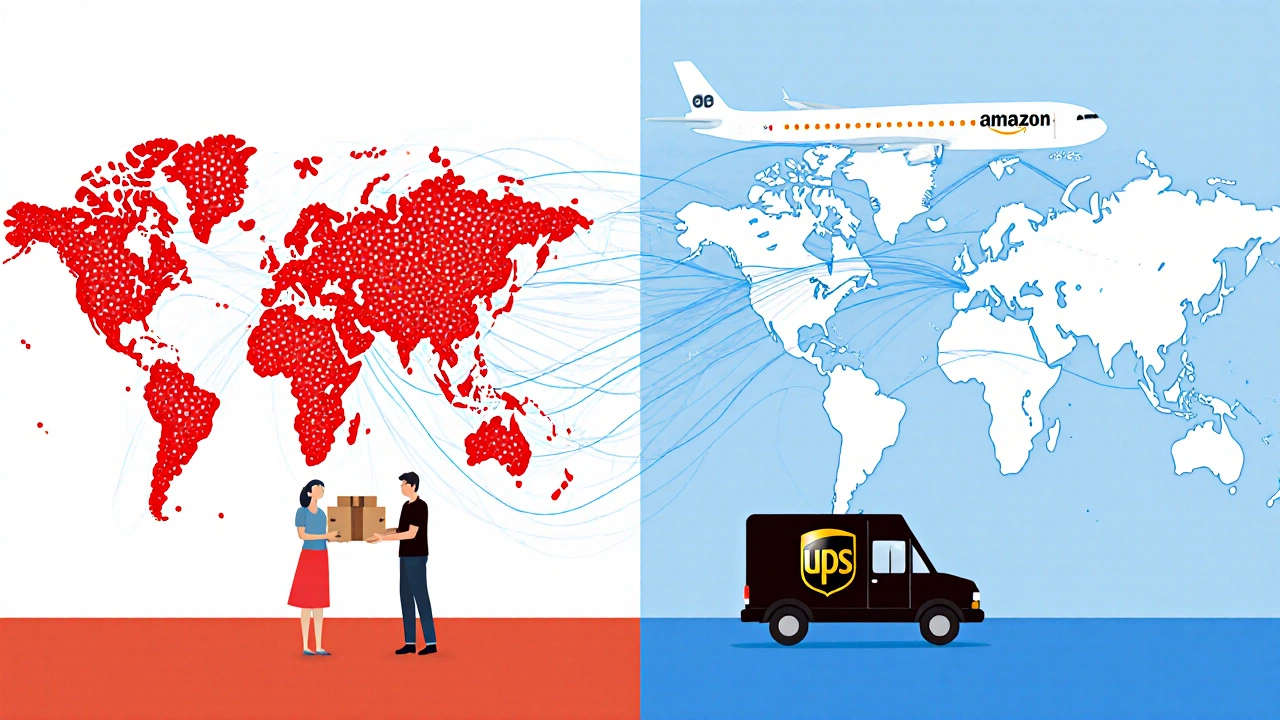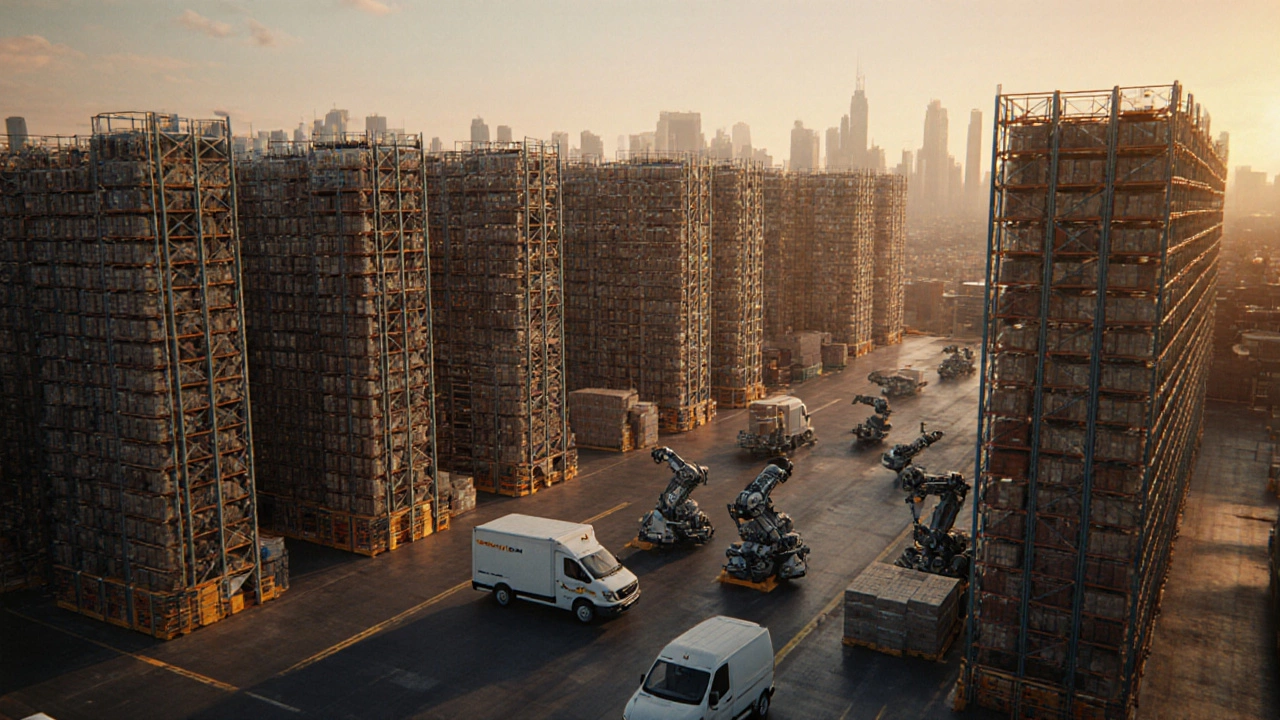Logistics Comparison Tool
Compare Delivery Options
Amazon handles more packages in a single day than UPS does in an entire week. That’s not a guess-it’s a fact backed by public filings and industry reports. If you’ve ever ordered a toaster, a book, or a pair of sneakers online and got it the next day, you’ve used Amazon’s logistics machine. But does that make it bigger than UPS, the company that’s been moving packages for over 115 years? The answer isn’t simple. Size isn’t just about packages. It’s about infrastructure, technology, control, and purpose. Let’s break it down.
Package Volume: Amazon Crushes UPS in Volume, But Not in Revenue
In 2024, Amazon delivered over 7 billion packages globally. That’s more than the combined volume of FedEx, UPS, and DHL. UPS, by comparison, moved about 5.8 billion packages in the same year. Amazon’s volume grew 18% year-over-year. UPS grew just 3%. The difference? Amazon isn’t just a carrier-it’s the customer. Most of its packages come from its own marketplace. UPS delivers for everyone: small businesses, hospitals, government agencies, and yes, Amazon too.
But here’s the twist: UPS made $97 billion in revenue in 2024. Amazon’s logistics division didn’t report separate profits-it’s buried inside Amazon’s overall financials. Analysts estimate Amazon spent $65 billion on logistics that year. So while Amazon moves more packages, UPS makes more money per package. Why? Because UPS charges market rates. Amazon doesn’t have to. It’s not trying to profit from delivery. It’s trying to win the entire shopping experience.
Network Scale: Amazon’s Warehouse Empire vs. UPS’s Global Hub System
Amazon operates more than 1,100 fulfillment centers worldwide. These aren’t just warehouses. They’re automated factories with robots, AI-driven sorting, and real-time inventory tracking. Each center can process over 1 million items a day. Amazon’s network is designed for speed: 2-hour delivery in some cities, same-day in over 100 metro areas.
UPS has 550 major facilities globally, including its massive Worldport hub in Louisville, Kentucky. That hub handles over 400,000 packages per hour during peak season. UPS’s strength is its air and ground network integration. It owns over 120 planes and 125,000 delivery vehicles. It has deep relationships with customs agencies in 220 countries. Amazon has been building its own air fleet-over 100 planes now-but it still relies on UPS and FedEx for international shipping outside its core markets.
Amazon’s network is dense and local. UPS’s is wide and global. One is optimized for speed. The other for reliability across borders.
Technology: Who’s Really Innovating?
Amazon’s logistics software isn’t just a tool-it’s the core of its business. Its algorithms predict what you’ll buy before you search for it. It moves inventory to warehouses before you click buy. Its route optimization software cuts delivery miles by 15% annually. It even uses machine learning to decide whether a package should fly or drive based on weather, traffic, and demand.
UPS’s technology is older but just as powerful. Its ORION system-On-Road Integrated Optimization and Navigation-has saved over 100 million miles since 2013. It calculates the most efficient route for every driver, down to the turn. UPS also uses AI to predict package delays, optimize truck loading, and reduce fuel use. Its My Choice platform lets customers reschedule deliveries, send packages to lockers, or redirect to a neighbor.
Amazon builds software to control its own ecosystem. UPS builds software to serve everyone else. Amazon’s tech is faster. UPS’s is more flexible.

Ownership: Control vs. Service
Amazon owns its entire delivery chain-from the warehouse floor to the last mile. It even owns its drivers through Amazon Flex and its own delivery service partners (DSPs). It doesn’t outsource to third-party carriers unless it has to. That control lets Amazon set its own rules: no signature required, no extra fees, no delays unless Amazon causes them.
UPS is a service provider. It doesn’t own your products. It doesn’t decide when you order. It just moves what’s handed to it. That makes UPS more vulnerable to market swings. When e-commerce slowed in 2023, UPS’s revenue dipped. Amazon’s didn’t. Amazon’s logistics is a shield against competition. UPS’s is its entire business.
Who’s Bigger? It Depends on What You Mean
If you measure size by package volume, Amazon wins. It moves more stuff, faster, in more places.
If you measure size by global reach, UPS wins. It delivers to remote islands, military bases, and rural villages where Amazon doesn’t even try.
If you measure size by technology investment, Amazon leads. It spends billions on automation and AI just to move its own stuff.
If you measure size by revenue and profitability, UPS wins. It turns delivery into a business. Amazon turns delivery into a weapon.
Amazon isn’t trying to be the biggest carrier. It’s trying to be the only carrier you need. UPS isn’t trying to replace Amazon. It’s trying to survive being used by Amazon.

What’s Next? The War for the Last Mile
Amazon is now opening delivery stations in towns where UPS has operated for decades. It’s offering lower rates to small sellers than UPS does. It’s testing drone delivery in the UK and Australia. It’s even experimenting with autonomous delivery robots.
UPS is fighting back. It launched UPS My Choice Plus for premium customers. It’s partnering with local post offices to extend coverage. It’s investing in electric delivery vans-over 10,000 already on the road. It’s also pushing its own marketplace for small businesses, hoping to reduce reliance on Amazon’s platform.
The real battle isn’t about who moves more boxes. It’s about who controls the customer relationship. Amazon wants to be the store, the warehouse, and the delivery truck. UPS wants to be the trusted partner that moves anything, anywhere, for anyone.
Final Answer: Amazon Is Bigger in Scale, But UPS Is Bigger in Scope
Amazon has the bigger network, the faster system, and the louder voice. But UPS still handles more types of shipments, serves more industries, and operates in more countries. Amazon’s size is focused. UPS’s size is deep.
If you’re a small business shipping one box to Canada, UPS is still the safer bet. If you’re a shopper in London wanting your order in two hours, Amazon wins.
Size isn’t just about numbers. It’s about power. Amazon uses its logistics to dominate retail. UPS uses its logistics to serve the world. One is a retail giant with a delivery arm. The other is a delivery giant that happens to be in retail.
So is Amazon logistics bigger than UPS? Yes-if you count packages and speed. No-if you count reach, reliability, and resilience. The truth? They’re not rivals. They’re different species in the same ecosystem.
Does Amazon deliver more packages than UPS?
Yes. In 2024, Amazon delivered over 7 billion packages worldwide, compared to UPS’s 5.8 billion. Amazon’s volume has grown rapidly because most of its shipments come from its own online marketplace. UPS moves fewer packages but serves a wider range of customers, including businesses, hospitals, and government agencies.
Which company has a larger delivery network?
Amazon has more fulfillment centers-over 1,100 globally-focused on fast, local delivery. UPS has fewer major facilities (around 550), but its network is more global and integrated, with 120+ aircraft and delivery routes in 220 countries. Amazon excels in urban speed; UPS excels in international reliability.
Is Amazon’s logistics technology better than UPS’s?
Amazon’s technology is more aggressive and automated, using AI to predict orders and optimize routes in real time. UPS’s ORION system is one of the most advanced route-planning tools in logistics, saving over 100 million miles since 2013. Amazon builds tech to control its own ecosystem. UPS builds tech to serve everyone else. Neither is universally better-it depends on the goal.
Why does UPS make more money than Amazon’s logistics division?
UPS charges market rates for every package it delivers. Amazon doesn’t. Amazon’s logistics division is designed to support its retail business, not to profit from shipping. In 2024, UPS made $97 billion in revenue. Amazon spent an estimated $65 billion on logistics. Amazon’s goal isn’t profit-it’s customer retention and faster delivery to beat competitors.
Can UPS compete with Amazon’s same-day delivery?
UPS offers same-day delivery in select cities through its UPS Express Critical service, but it’s expensive and limited. Amazon’s same-day delivery is widespread, cheap, and integrated into its app. UPS can’t match Amazon’s scale in speed because it doesn’t control the inventory or the customer demand. However, UPS is expanding its local delivery options and partnering with retailers to offer faster options without needing to own the products.





